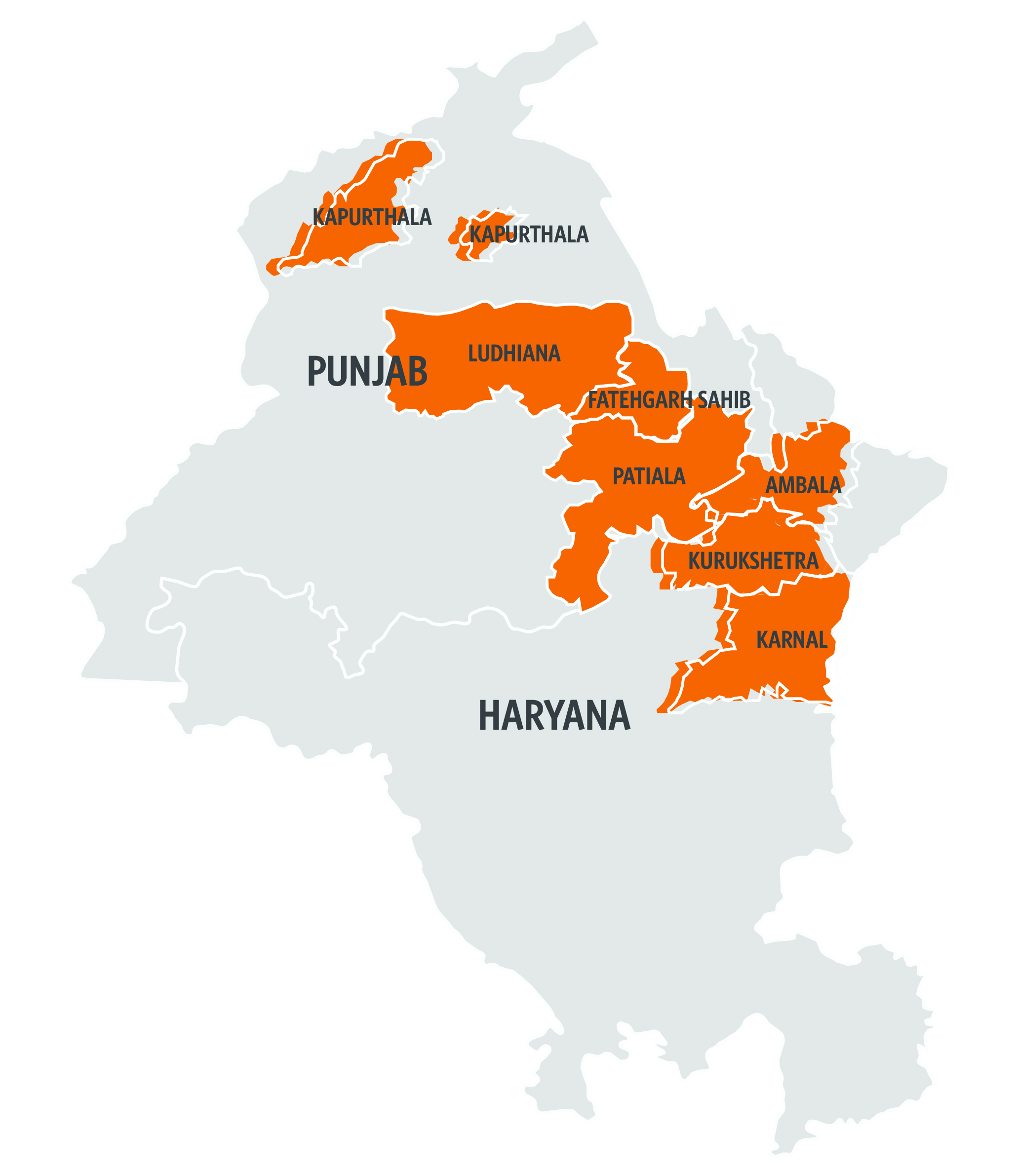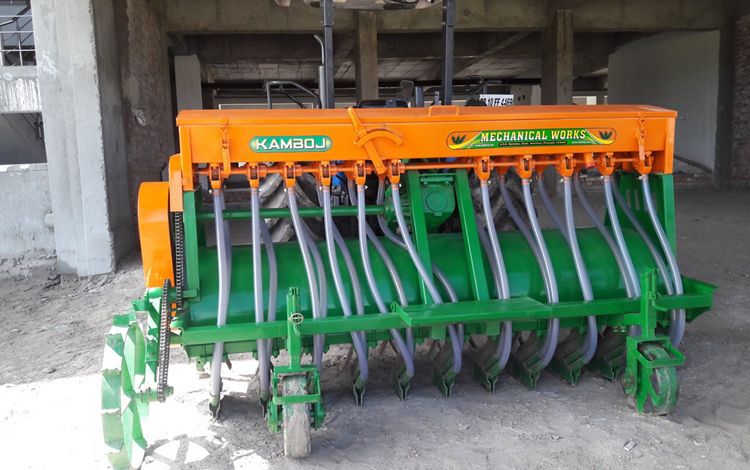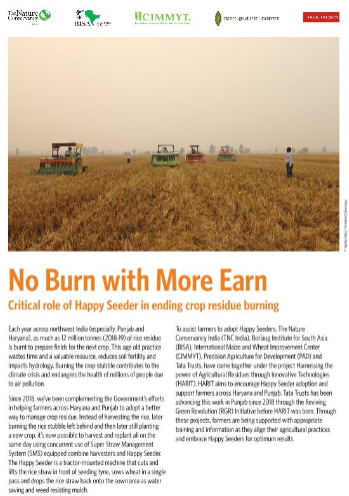Provide Food and Water Sustainably
Harnessing the power of Agricultural Residues through Innovative Technologies (HARIT)
Project HARIT aims to end crop residue burning to benefit farmers and the environment
A burning problem that needs to be addressed
Burning crop residue in agricultural fields during the harvest season has long been a major cause of air pollution in northwest India. Farmers in Haryana and Punjab resort to paddy residue burning because their combine harvesters leave crop residues (stubble) in the field. Farmers find burning this residue an easy solution during the short period of time they have between harvesting the rice and planting the next wheat crop. While convenient, this burning causes a number of significant problems. Most noticeably it produces massive plumes of smoke that not only envelop Punjab and Haryana, but also travel in the wind to India’s capital territory and surrounding regions. This is known to increase the risk of respiratory diseases.

HARIT Project districts in Punjab and Haryana states
Crop residue burning has created an immense environmental and public health crisis. On top of the smoke problem, it:
- diminishes soil health and productivity,
- increases farming costs risking the economic security of farming families,
- significantly increases greenhouse gas emissions, worsening climate change,
- increases the loss of water from the soil, and
- wastes a valuable soil carbon resource.
A ready to go solution
The good news is that all of these problems can be addressed with a change in the way crop residue is treated.
The Happy Seeder is a piece of conservation agricultural technology that does away with paddy residue burning. The tractor-mounted Happy Seeder cuts and lifts straw, sows wheat and returns the rice straw onto the sown areas as mulch. This improves soil fertility and increases farm yields while saving water and being weed resistant.
The Government has provided an INR 2,000 crores (US$287 million) subsidy to promote the adoption of in-situ crop residue management practices. This capital subsidy helps add crop residue management machines, including Happy Seeders, to aid residue management in Haryana and Punjab. However, the Happy Seeder has slow adoption rates among risk-averse farmers mostly because they are unaware of sound alternatives to burning available in the market.
Hence, there is a need to:
- educate farmers on the multiple benefits of the Happy Seeder,
- build their capacity to use the technology appropriately,
- ensure the availability of the machines during the ‘burn season’, and
- demonstrate proof of the concept.
This is precisely where The Nature Conservancy and our partners [Borlaug Institute for South Asia (BISA), International Maize and Wheat Improvement Center (CIMMYT), Precision Development and Tata Trusts] have stepped in with a project we call Harnessing the power of Agricultural Residues through Innovative Technologies or HARIT. Launched in 2018, HARIT aims to encourage Happy Seeder adoption and support farmers in 105 selected villages across seven districts of Haryana and Punjab. HARIT’s ultimate objective is to eliminate crop residue burning in Haryana and Punjab by 2024.
Another farming revolution for India?
The Happy Seeder has been identified by the National Academy of Agricultural Sciences and the Government of India as one of the most cost-effective and scalable innovations to manage in-field crop residue. This, and the other above-mentioned benefits of Happy Seeder use, were corroborated in a research paper published by Science.

Facilitating easy access to Happy Seeders
HARIT seeks to decrease burning, facilitate Happy Seeder adoption and support farmers across Haryana and Punjab by leveraging the opportunity provided by the government subsidy. The project shares information, practices and the benefits of the Happy Seeder by deploying extensive awareness and capacity building programs. This enhances knowledge and addresses the capacity gaps that exist in the correct use of Happy Seeders.
We are using villages that commit to zero burning and the use of Happy Seeders as exemplars to replicate such models in other villages. Seminars and workshops are enabling farmers to have hands-on experience of the Happy Seeder. Farmers are sharing their personal experiences of using the Happy Seeder – and the many benefits they are reaping – with their peers and the larger farming community.
Download
Know more about project HARIT and the critical role of the Happy Seeder in reducing crop residue burning.
DOWNLOADAdditionally, mobile advisory units set up under the project ensure constant dialogue between farmers and experts. Under the project, farmers have easy access to precise and regular information and timely solutions to their problems via voice calls and messages.
HARIT also hopes to align policy and government support systems around sustainable and scalable conservational agriculture technology that will end crop residue burning.
Multiple wins with the Happy Seeder
To demonstrate the benefits of Happy Seeders use further, we compared results in paired fields located side by side – some using the Happy Seeder and others the traditional method for sowing wheat (776 samples across seven project districts). The Happy Seeder sown wheat fields had a net yield gain of 0.34 to 0.40 tonnes per hectare and a net income gain of INR 9,949 (US$137) to INR 11,910 (US$164) per hectare.
After one year of Project HARIT interventions there was a:
- 15% increase in farmers’ access (own or rent) to a Happy Seeder.
- 11% increase in farmers adopting the Happy Seeder in pilot and non-pilot villages through demonstration and communication activities.
- 15% increase in the net profit of farmers using the Happy Seeder over those using traditional methods in pilot villages.
- 11% reduction in the total area burnt.
Future opportunities
In the next few years, we plan to build collaborations and increase policy engagements with working groups, village panchayats, Departments of the State Governments, and ‘agripreneurs’ working on crop residue management. This includes:
- Providing performance-based grants for in-situ crop residue management.
- Removing barriers like machine access, demand-supply mismatch and the more effective management of crop residue management machines.
We also plan to significantly scale up our field operations by:
- Training a cohort of 150 ‘agripreneurs’ to improve access to residue management machines.
- Promoting regenerative agriculture and no-burn technology through new projects.
- Piloting financial instruments that incentivize farmers to adopt no-burn practices to reduce air pollution.
Seeding with the Happy Seeder











Collaborate with us for multiple wins
Your support will help us take this proven sustainable technology to a massive scale where we will be able to end crop residue burning across northwest India by 2024. It will also enable multiple wins in terms of improved livelihoods of an estimated 2.5 million farmers, at least 2.8 million tonnes of CO2 emissions saved each year, lower water use with increased water tables, decreased air pollution levels, improved human and soil health across northwest India.
We express our sincerest gratitude to Tata Trusts for their continued support and generous donations towards this project.





